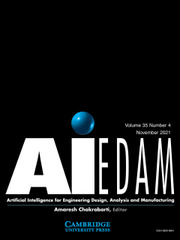Crossref Citations
This article has been cited by the following publications. This list is generated based on data provided by
Crossref.
Gaetani, Isabella
Hoes, Pieter-Jan
and
Hensen, Jan L.M.
2017.
On the sensitivity to different aspects of occupant behaviour for selecting the appropriate modelling complexity in building performance predictions.
Journal of Building Performance Simulation,
Vol. 10,
Issue. 5-6,
p.
601.
Shahinur, Sweety
Ullah, A.M.M. Sharif
Noor-E-Alam, Muhammad
Haniu, Hiroyuki
and
Kubo, Akihiko
2017.
A decision model for making decisions under epistemic uncertainty and its application to select materials.
Artificial Intelligence for Engineering Design, Analysis and Manufacturing,
Vol. 31,
Issue. 3,
p.
298.
Bamdad, Keivan
Cholette, Michael E.
Guan, Lisa
and
Bell, John
2018.
Building energy optimisation under uncertainty using ACOMV algorithm.
Energy and Buildings,
Vol. 167,
Issue. ,
p.
322.
Hester, Joshua
Miller, T. Reed
Gregory, Jeremy
and
Kirchain, Randolph
2018.
Actionable insights with less data: guiding early building design decisions with streamlined probabilistic life cycle assessment.
The International Journal of Life Cycle Assessment,
Vol. 23,
Issue. 10,
p.
1903.
2018.
Building Performance Analysis.
p.
323.
2018.
Building Performance Analysis.
p.
503.
Kotireddy, Rajesh
Loonen, Roel
Hoes, Pieter-Jan
and
Hensen, Jan L.M.
2019.
Building performance robustness assessment: Comparative study and demonstration using scenario analysis.
Energy and Buildings,
Vol. 202,
Issue. ,
p.
109362.
Loonen, R. C. G. M.
de Klijn-Chevalerias, M. L.
and
Hensen, J. L. M.
2019.
Opportunities and pitfalls of using building performance simulation in explorative R&D contexts.
Journal of Building Performance Simulation,
Vol. 12,
Issue. 3,
p.
272.
Rezaee, Roya
Brown, Jason
Haymaker, John
and
Augenbroe, Godfried
2019.
A novel inverse data driven modelling approach to performance-based building design during early stages.
Advanced Engineering Informatics,
Vol. 41,
Issue. ,
p.
100925.
Rezaee, Roya
Brown, Jason
Haymaker, John
and
Augenbroe, Godfried
2019.
A new approach to performance-based building design exploration using linear inverse modeling.
Journal of Building Performance Simulation,
Vol. 12,
Issue. 3,
p.
246.
Abualdenien, Jimmy
and
Borrmann, André
2020.
Vagueness visualization in building models across different design stages.
Advanced Engineering Informatics,
Vol. 45,
Issue. ,
p.
101107.
Harter, Hannes
Singh, Manav Mahan
Schneider-Marin, Patricia
Lang, Werner
and
Geyer, Philipp
2020.
Uncertainty Analysis of Life Cycle Energy Assessment in Early Stages of Design.
Energy and Buildings,
Vol. 208,
Issue. ,
p.
109635.
Lu, Shuai
Li, Jingyu
and
Lin, Borong
2020.
Reliability analysis of an energy-based form optimization of office buildings under uncertainties in envelope and occupant parameters.
Energy and Buildings,
Vol. 209,
Issue. ,
p.
109707.
Singh, Manav Mahan
Singaravel, Sundaravelpandian
Klein, Ralf
and
Geyer, Philipp
2020.
Quick energy prediction and comparison of options at the early design stage.
Advanced Engineering Informatics,
Vol. 46,
Issue. ,
p.
101185.
Gaetani, Isabella
Hoes, Pieter-Jan
and
Hensen, Jan L. M.
2020.
A stepwise approach for assessing the appropriate occupant behaviour modelling in building performance simulation.
Journal of Building Performance Simulation,
Vol. 13,
Issue. 3,
p.
362.
Lu, Shuai
Wang, Chunxiao
Fan, Yue
and
Lin, Borong
2021.
Robustness of building energy optimization with uncertainties using deterministic and stochastic methods: Analysis of two forms.
Building and Environment,
Vol. 205,
Issue. ,
p.
108185.
Sylvester, Siera
Hughes, Jalaycia
and
Clark II, Clayton
2022.
Application of Epistemic Uncertainty Analysis and Sensitivity Analysis in Green Construction Design.
Advances in Environmental and Engineering Research,
Vol. 03,
Issue. 02,
p.
1.
Zhang, Yuxuan
Xiao, Bo
Al-Hussein, Mohamed
and
Li, Xinming
2022.
Prediction of human restorative experience for human-centered residential architecture design: A non-immersive VR–DOE-based machine learning method.
Automation in Construction,
Vol. 136,
Issue. ,
p.
104189.
Li, Chao
Zahedi, Ata
and
Petzold, Frank
2022.
Pragmatic Design Decision Support for Additive Construction Using Formal Knowledge and Its Prospects for Synergy with a Feedback Mechanism.
Buildings,
Vol. 12,
Issue. 12,
p.
2072.
Esteghamati, Mohsen Zaker
Rodriguez-Marek, Adrian
and
Flint, Madeleine M.
2023.
Resilient and Sustainable Buildings.
p.
177.

